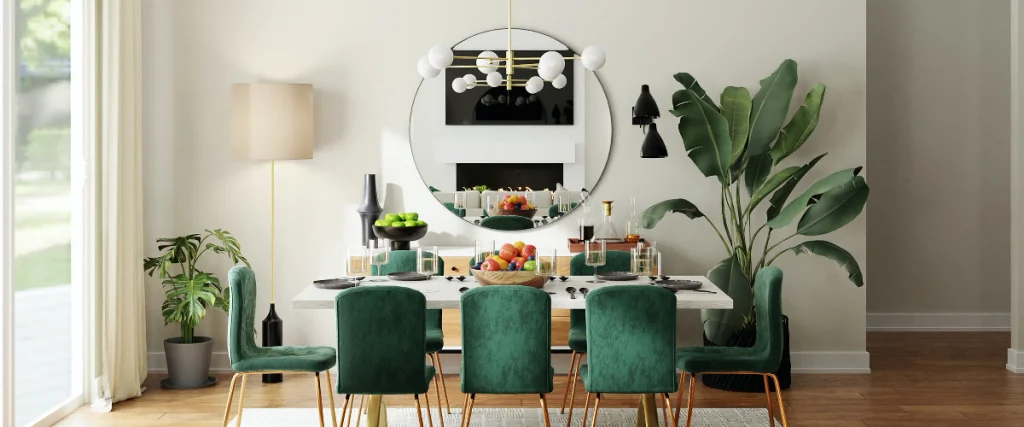
When buying a dining table, one of the first things to consider is the size of the table in relation to your dining space. You want to ensure that the table fits comfortably in the room without crowding other furniture or blocking walkways. A good rule of thumb is to leave at least three feet of space around the table for people to move in and out easily. Additionally, think about the of people you typically host at your table.
If you often have family gatherings or dinner parties, you may want a larger table with extendable options or extra leaves. On the other hand, if your dining area is small and you usually only dine with a few people, a more compact table might be a better choice. Also, take note of the table’s shape. Round tables are great for smaller areas and create a cozy atmosphere, while rectangular tables can accommodate more diners and fit nicely in longer spaces. Ultimately, your table’s size should provide comfort and functionality, allowing you to enjoy meals with family and friends without feeling cramped.
Another important factor to consider is the material of the table. Dining tables come in various materials such as wood, glass, metal, and even plastic. Each material has its own unique feel and look, influencing both the style of your dining room and the table’s durability. For instance, wooden tables tend to offer a classic and warm ambiance, making them a popular choice for many homes. They can be solid hardwood, which is sturdy and long-lasting, or a veneer, which may be more budget-friendly but less durable. Glass tables, on the other hand, can create a modern and elegant vibe, but they often require more maintenance due to smudges and fingerprints.
Metal tables can provide an industrial look, which might appeal to contemporary styles. When evaluating materials, consider how much wear and tear the table will experience. If you have young children or pets, opting for a material that’s easy to clean and resistant to scratches and spills might be wise. Lastly, think about how well the material matches your existing furniture and decor for a cohesive look in your dining area.
In addition to size and material, the style of the dining table plays a crucial role in your decision-making process. The table should not only serve its functional purpose but also complement the overall aesthetic of your home. There are various styles to choose from, ranging from traditional to modern and everything in between. If your home has a rustic or country feel, a farmhouse-style table with a distressed finish may suit your space well, creating a warm and welcoming atmosphere.
Conversely, if your home features sleek lines and contemporary decor, a minimalist table with a glass or metal finish could enhance that modern theme. Besides the style, consider the table’s design details, such as the legs, edges, and finish. Some tables have intricate carvings or unique shapes that could serve as a statement piece in your dining area. Think of how your dining table’s design can reflect your personal taste and values. Finding the right style, which harmonizes with your surroundings and expresses who you are, is a significant aspect when choosing a dining table.
Another factor to keep in mind when buying a dining table is mobility and functionality. If you plan to move the table around for cleaning or re-arranging the room, consider a table that is lightweight and easy to move. Some tables come with wheels or casters, making them more convenient to shift as required. Additionally, think about whether you want a fixed table or one with extendable features. An extendable dining table can be a game-changer for those who love hosting guests, as it allows you to adapt to different s of diners with ease.
You can have a compact table for daily meals and then easily expand it for larger gatherings. Pay attention to how the extension mechanism works and ensure it’s user-friendly. Also, consider the height of the dining table. Standard dining tables are usually around 28 to 30 inches high, perfect for standard dining chairs. However, if you prefer a specific seating style or have kids, looking into counter-height or bar-height tables might also be advantageous. Ensuring the table suits your lifestyle not only contributes to comfort but also enriches your dining experiences.
Lastly, budget is always an essential aspect when purchasing a dining table. Before you start shopping, determine a reasonable price range that you are willing to invest. Dining tables can vary significantly in price based on factors like material, brand, design, and size. It’s important to remember that a higher price tag does not always equate to better quality. Research various options to ensure that you’re getting the best value for your money. Don’t hesitate to explore second-hand shops or online marketplaces, where you might find high-quality tables at a fraction of the retail price.
Take your time to compare prices and check reviews to get an idea of the table’s durability and functionality. Additionally, keep an eye out for sales or discounts, especially during holiday periods. While it might be tempting to opt for the cheapest option, investing a bit more in a well-made table that meets your needs can save you money in the long run, as it will likely last longer and withstand the test of time. Balancing quality with budget will lead you to a great dining table that fits not only your style but also your financial situation.